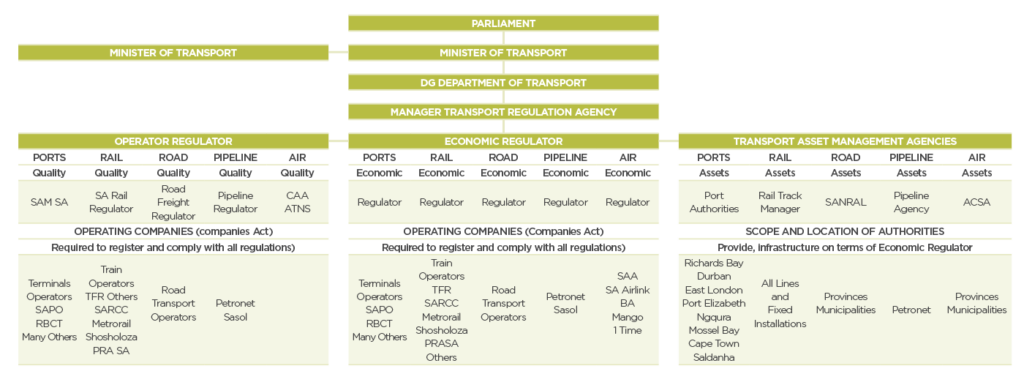Transport regulation in South Africa: an epic fail!
Transport regulation in South Africa: an epic fail!
Commercial transport is largely unregulated in South Africa and, as NICK PORÉE points out, this is a recipe for disaster.
Effective regulation of commercial transport in all modes is based on principles that provide the essential foundation to control standards of operation. The successful international regulation of shipping (via the International Maritime Organization), airlines (International Air Transport Association), and road freight (International Road Transport Union and organisations like the UK’s Driver and Vehicle Standards Agency) is based on the application of these principles.
The fundamental requirements are:
- Registration of operators and their vehicles, drivers, and bases (by application, qualification, accreditation, and commitment to compliance)
- Identification of responsible persons (to ensure accountability)
- Definition of operational standards
- Monitoring of compliance
- Sanctions for non-compliance
In South Africa from 1700 to 1850, freight transport was mainly animal-drawn, followed by a railway monopoly from 1850 to 1980. While the railways continued to operate to a lesser and lesser degree, from 1980 to 2022 we shifted to road freight. The earliest period was uncontrolled, while between 1850 and 2022 the railways were completely self-controlled. When road freight was deregulated in 1985, an initial attempt was made to apply the principles of the Road Transport Quality System (RTQS). However, this was shrugged off by both the authorities (Department of Transport and provinces) and the industry (Public Hauliers Association) – either through ignorance or intent.
The current structure is skewed by the dominance of state-owned companies (SOCs) and the government’s failure to recognise the fundamentals of transport regulatory processes. These are illustrated in diagram 1.
Traffic Regulatory Activities | ||
The definition and administration of these activities are national prerogatives and may or may not be harmonised with neighbouring States | Traffic Officials | Goverment Agencies |
Road Traffic Regulation | Vehicle Administration | |
Road usage Loads Vehicle condition – COR Vehicle standards Driver licensing Road safety Enforcement Violations | Records – ownership Vehicle details Licence / registration Fees administration Scrapping | |
(These activities are applicable to all vehicles on Public Roads) | ||
Commercial Transport Regulation | ||
These national activities may be harmonised with neighbouring countries to facilitate regional trade and movement of persons whilst controlling the quality of operations | Passenger Transport Regulator | Freight Transport Regulator |
Passenger Transport | Freight Transport TTTFP & RFS | |
Operator Firm details Vehicles Drivers Operations Routes Schedules Passenger fees Reporting | Operator Firm details Vehicles Drivers Operations Traffic infringements Admin. violations Grading | |
(These activities are only applicable to commercial transport operations) | ||
Diagram 1: Traffic And Transport Regulatory Framework
South Africa has implemented three of the four regulatory activities (very inefficiently, in many areas) but not the regulation of commercial freight transport. The result is the situation in which we find ourselves 40 years later. The railway operations are self-regulated (with disastrous consequences), while road transporters are unregulated. Drivers are badly trained, vehicles are badly maintained, authorities cannot exert effective control because there is no system of monitoring, and there are no responsible persons defined.
Neither is there a competent agency with qualified staff responsible for the control of operational quality or safety. All we have are under-resourced provincial road traffic police, a voracious Road Traffic Management Corporation, an ineffective Railway Safety Regulator, anomalous regulations, and no competent direction or coordination. All of these issues – and effective solutions – were described in NATMAP 2008, National Freight Logistics Strategy 2016, and the Road Freight Strategy approved by cabinet in 2017. These attempts to improve the situation have repeatedly been ignored by the Department of Transport.
Road freight operator registration is being implemented by the SADC-COMESA-EAC Tripartite Alliance for 27 countries, but South Africa has withdrawn from the Tripartite Transport and Trade Facilitation Program (TTTFP).
We are now facing the same issues with the intended privatisation of railways. Our national railways (and our airways and ports) have been allowed to virtually collapse due to unqualified and corrupt management. This will continue unless effective regulatory institutional capacity, as well as responsibility, systems, and regulations, are settled before the new train operators are permitted on the rails. In order to achieve regulated competition and ensure the coordination, monitoring, and control of train operations, there must be changes to track ownership and the regulation of access charges and systems. Railway operations require tight coordination and adherence to standards for safety and efficiency, so it is essential to design and implement the entire system before starting operations. If new operators are allowed onto Transnet’s rails on its corporate terms, this amounts to a permit system controlled by a company; this is not effective national competitive railway regulation.
It is an ideal time to restructure government involvement in freight transport. This will involve integrating commercialised and competitive road and railway systems, as well as agencies, into a well-structured Ministry of Transport, populated with qualified staff and competent management. This will eliminate the expensive and irrelevant agencies of the current Department of Transport and release the funds to create an effective management structure for the future.
The state agencies and departments do not have the qualified and internationally-experienced personnel needed to introduce the necessary changes. The historical system of regarding the SOCs as the government transport planners for the ports, railways, airways, and pipelines of the country has failed the economy and is contributing to the destruction of the industry. It is essential that the private sector is involved in defining the systems required to restore efficiency to the regulation of commercial freight transport in all modes. The situation with the planning of the ports of Durban, Cape Town, and Richards Bay illustrates the narrow corporate vision of Transnet, which continues to lose trade to other regions.
These issues are central to the current Regulation of Transport Bill, which must be aligned with the future structure of freight transport regulation. Framing these regulations is not material for committee negotiations and bargaining. It requires professional input – drawing on international best practice to create an efficient environment for private industry – and efficient logistics to rebuild the economy by regulated competition.
Several of the departments and agencies shown in diagram 2 are already in existence and the whole framework can be implemented within the existing legislative hierarchy. All it takes is the coordination of transport under one competent ministry and the restructuring of ineffective agencies.
It is essential that all modes of freight transport are aligned with the needs of private sector industrial customers, not the aspirations of SOCs and government departments. Freight transport is a critically important service for agriculture, industry, and commerce. It is the lifeblood of the economy. South Africa must create a platform for competitive logistics to support the African Continental Free Trade Area (AfCTFA) and to stop the current industrial disinvestment and dispersion of trade to other ports and corridors.
The current situation is fraught with built-in system failures, and is desperately in need of professional analysis and rectification of each function to make them fit for purpose. The process requires an immediate review of the National Infrastructure Plan, strategic integrated projects, the Reconstruction and Development Programme, Operation Vulindlela, and any other “masterplans”, in order to align them to a future framework for efficiency.
Failure to act will see increasing shifts to other ports and investment destinations. This is already happening: Maputo was up 20% last year and Dar es Salaam up 40% while Durban, Richards Bay, and Cape Town are hampered by costs and inefficiencies caused by the current government obfuscation and inertia.

Published by
Nick Porée
focusmagsa



